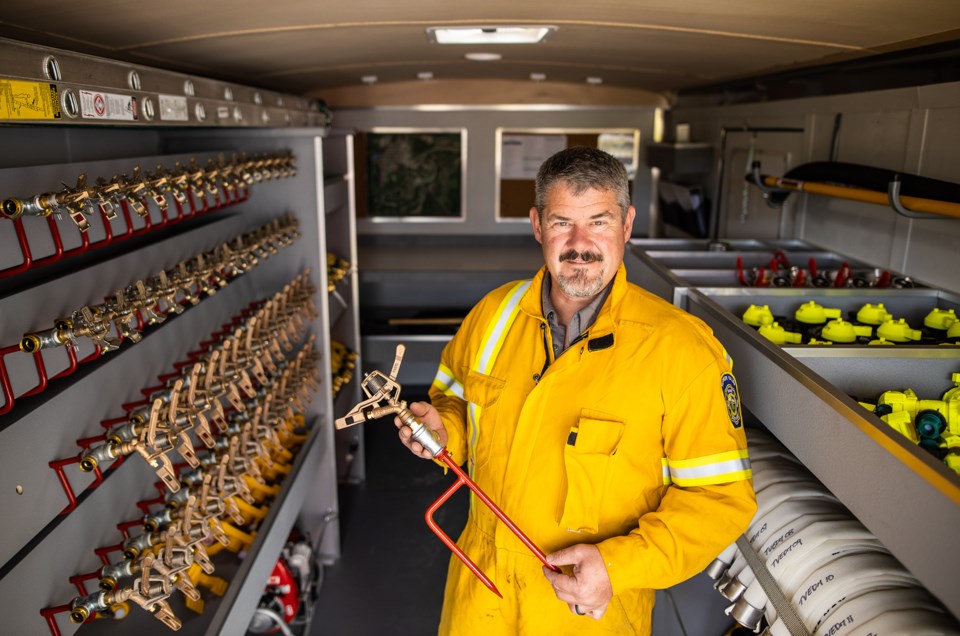Firefighters now have an extra tool under their belt when it comes to battling wildland blazes.
Turner Valley director of emergency management, Gerry Rooke, built a structural protection unit this summer that acts as a defensive mechanism in wildfires threatening urban areas, allowing firefighters to better save homes by deploying sprinklers on buildings and creating sizeable defense lines.
Turner Valley Town council approved the project in last year’s budget. The cost to date is $38,396, which is covered by Municipal Sustainability Initiative funds.
Rooke said the mobile trailer consists of critical tools to help firefighters battle wildfires. It includes, but isn't limited to, more than 100 impact and rotary sprinklers, 7,100 feet of hose, a high-pressure lightweight pump capable of delivering water over great distances and portable bladders.
“It’s state-of-the-art when it comes to wildland urban interface fires,” said Rooke. “We can run out hoses, set them up and the premise is it stops everything from burning. We can deploy in areas that’s too dangerous to engage the fire and work behind the wet line where conditions are safer to extinguish the fire.”
Rooke said the structural protection unit - which is becoming more common in firefighting but fairly unique in Foothills County - acts as a defensive strategy.
“As a fire gets really large it takes a tremendous amount of resources to fight offensively,” he said. “If it gets too hot it takes too much water to extinguish it and it gets very dangerous. What we’re doing (with the sprinkler protection unit is) we’re getting ahead of the fire and then preventing the fire from spreading or burning structures.”
During forest fires, embers can travel fair distances and ignite mulched flowerbeds, woodpiles and dead leaves and pinecones in gutters, resulting in structure fires.
Rooke said firefighters can get ahead of the fire, set sprinklers on structures, lay down perimeter lines and walk away, freeing up their time to do other tasks.
“We use the sprinklers, essentially, to dampen down all of those fuels,” he said. “This is a wonderful tool in areas where we can’t easily access with a vehicle or if it’s too dangerous for firefighters. If you consider a house in the MD surrounded by trees we can put sprinklers on it and then leave it and not have firefighters in a position of entrapment.”
In Foothills County, the Turner Valley Fire Department can face several wildfires in a year, depending on weather conditions, said Rooke.
“We’re fairly dependent on the fact that we’ve got enough population that they’re discovered early and we get on to them before they get big,” he said. “There is the potential for a fire to go unrecognized or simply in extreme weather conditions these fires can go very large very rapidly where they get very big.”
Rooke said he expects this to occur more frequently with the weather patterns he’s seeing in southern Alberta. Therefore, another tool to mitigate these types of fires is critical, he said.
“The consequences of the Slave Lake, Fort Mac, the Waterton fires that we experienced is pretty significant,” he said. “It has huge social and economic impacts. It adds another tool and an arsenal to deal with these wild land interface fires.”
With forestry land west of Turner Valley and crops and willow stands throughout the county, Turner Valley Fire Chief Glenn Baxter also sees the structural protection unit as a must-have.
“We’ve had grass fires that are wind driven that the sprinkler system could be deployed to create a fire break along a natural fire barrier like a road to prevent the fire from jumping the barrier,” he said. “In our area there’s a good likelihood that it could be deployed in some years multiple times and other years it might not be required. The need will change depending on our climate. It’s very cyclical. Last year our wildfires and grass fires were down compared to the average and this year we’re average.”
Baxter said the structural protection unit allows firefighters to keep protection in place where it might not be safe for firefighters to remain and then they can return for clean up once it’s safe to do so.
“It could replace a significant number of firefighters in the way it can continue to protect an area under long durations,” he said. “The sprinklers continue running and the firefighters are out safely and the structures are still protected. There’s been plenty of cases where the sprinkler system protected structures and absolutely everything around them is burnt.”
Members of the fire department participated in wildfire training course through the Alberta Sustainable Resource Development earlier this year, and have been familiarized with the structural unit.




